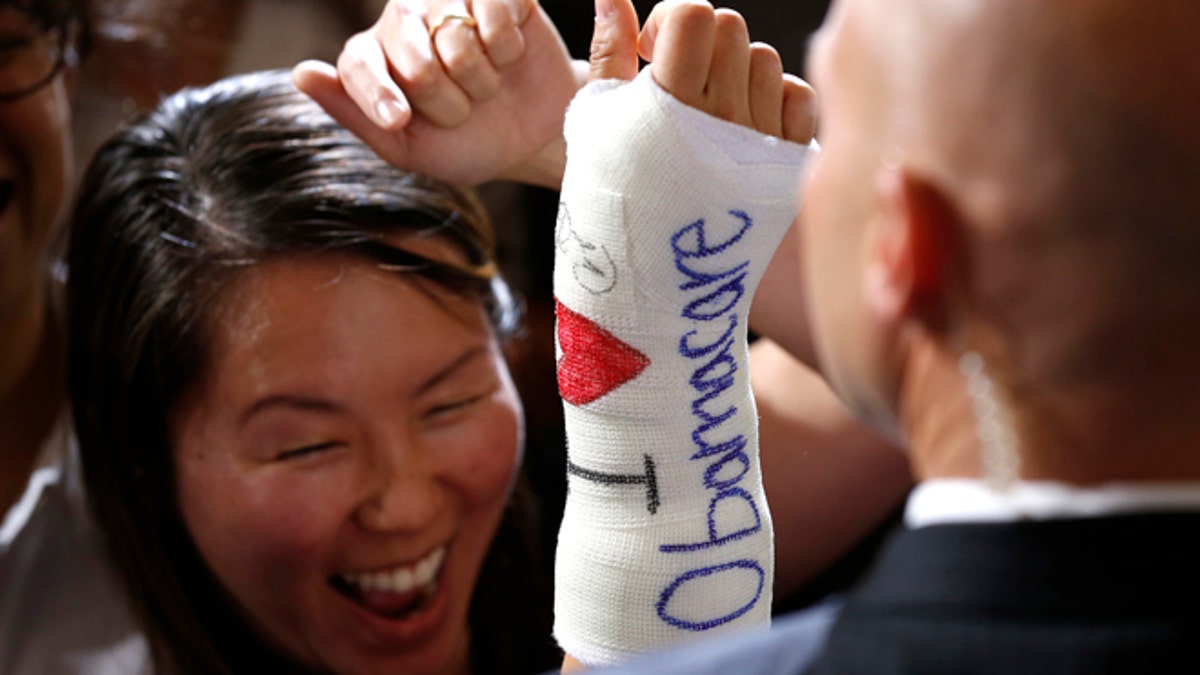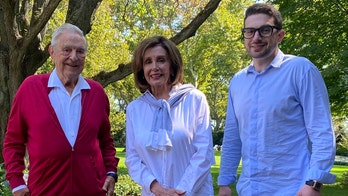
FILE: October 30, 2013: A Massachusetts woman after President Obama signed her cast in Boston, Mass. (REUTERS)
ObamaCare appears at least for now to be off life support -- after a total 2.1 million Americans enrolled to get insurance coverage this year. But whether President Obama’s signature health care law survives -- at least in its entirety -- remains uncertain.
Despite House Minority Leader Nancy Pelosi and other ardent supporters of ObamaCare declaring that it remains “the law of the land,” other congressional Democrats facing re-election this year have hinted at cannibalizing the legislation in the face of a confused and frustrated electorate.
In early November, 39 House Democrats, including many in battleground districts, voted to allow millions of Americans to keep the health care plans they lost under ObamaCare, joining Republicans who have rigorously opposed the 2010 law since then-presidential candidate Obama proposed it in 2007.
Weeks after the recent House vote, Sen. Mary Landrieu, D-La., among the most vulnerable Senate Democrats and who had roughly 90,000 people in her home state get their insurance revoked, also broke with her party by introducing a similar bill.
Yet the broader issue looming beyond the politics is whether the entire, federally subsidized program can become self-sustainable by getting enough enrollees, preferably younger Americans, or fall into what critics are calling the “death spiral.”
Their argument is that the administration will need millions of younger, healthy Americans to sign up to cover the costs of older enrollees who typically need more medical care. And without the young and healthy, insurance companies will increase prices to cover their losses, which will result in fewer enrollees and some sort of government intervention, the critics further argue.
“If they do [succeed,] it'll be pure, irrational dumb luck,” said Dan Holler of Heritage Action for America, which has helped lead efforts to “defund” ObamaCare. “The program they designed, and the incentives they put in place, look destined to fail.”
Holler argued Tuesday that ObamaCare problems are systemic, with doctors eventually no longer accepting low reimbursements and Americans “refusing to spend exorbitant amounts of money on plans that won't allow them to keep their doctor.”
However, the results of Kaiser Family Foundation study released last week suggest only a slight increase in insurance premiums in 2015, despite low enrollment so far by young people. (Rates are already locked in for 2014.)
"It is nowhere near what is sometimes referred to as a death spiral," Larry Levitt, a health economist at the foundation, said following the report's release, according to Reuters.
Preliminary figures suggest roughly 25 percent of Americans who have so far signing up for ObamaCare are in the crucial 18-to-34 age group, below the administration's goal of roughly 40 percent.
The administration has said it needs to enroll roughly 7 million Americans by March 31, on its way to expanding coverage to 25 million by 2016.
However, Levitt said, “It doesn’t matter how many people sign up. What matters more is the proportions.”
And on Monday, Howard Dean -- a former Vermont governor, presidential candidate and Democratic National Committee chairman – suggested the so-called "individual mandate" in ObamaCare that requires Americans to purchase insurance or face a tax penalty might not have been needed for the program to be successful.
He told CNBC that actuarial data does not lead to the conclusion that huge cost overruns will result without the mandate.
"Insurance companies like it because it does bring young, healthy people who aren't likely to get sick into the system," he said. "But our experience [in Vermont,] although it's with young people under 18, not with everybody, is that the individual mandate was not that necessary."




